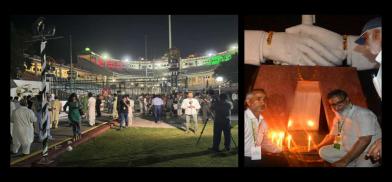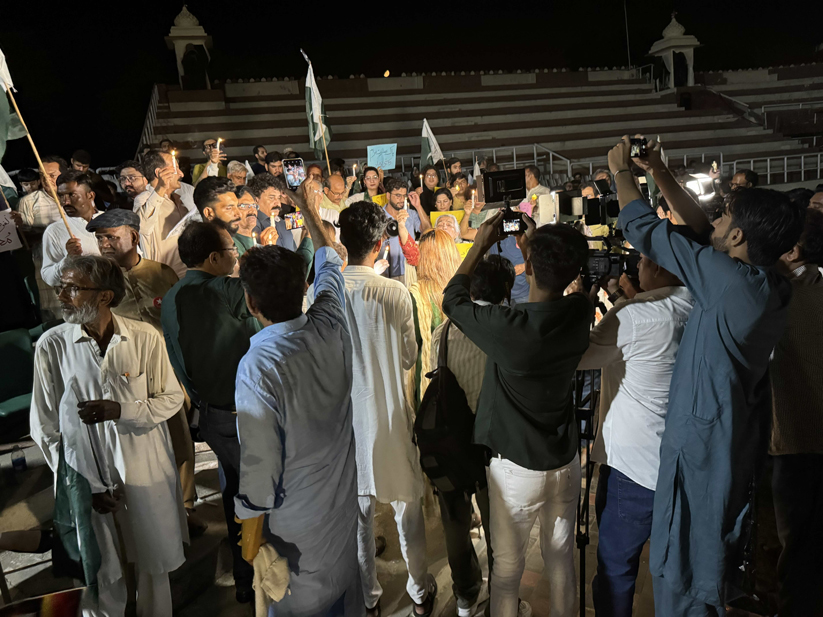So near yet so far: An aborted rendezvous of Indian, Pakistani peace activists at Wagah
What is so threatening about letting a few hundred peace activists in a combined population of over a billion meet for a few moments at a heavily guarded border?

If it's not one, it's the other," commented Salima Hashmi with a wry smile. The prominent artist and educator in Lahore was referring to the Indian authorities' refusal to allow a peace delegation to participate in a joint celebration of India-Pakistan independence days at the Wagah border last week.
This event established in 1996 took place annually until 2014, when Pakistan denied activists permission to reach the restricted area.
India has never officially denied this permission. So despite the Pakistanis' absence over the past decade, Indian 'peacemongers' as I term them, have gone to Zero Point every year, commemorating Pakistan's Independence Day, celebrated on 14 August, as well as India's, 15 August.
They would see into Pakistan, "chant peace slogans, leave candles at the gate, and return," Ramesh Yadav of Punjab Folklore Society told me.
They were stopped last year, but it didn't matter so much because there were no Pakistanis on the other side anyway. This year was different.

Permission
The process to obtain permission begins months in advance on either side. Organisers submit applications to the local authorities, and then send in a list of participants and their identification details, plus vehicle registration numbers.
This year, to his surprise, Pakistan approved the application submitted by well-known journalist Imtiaz Alam, Secretary General of the South Asia Free Media Association.
There was great excitement and anticipation on both sides about this cross-border meeting taking place after a long gap.
Some 250 Pakistanis sent in their details. I was among the 150 who were approved.
About 100 Indians obtained similar permission on their side, for participants from various areas including Delhi, Lucknow, Chandigarh, Himachal, Haryana, Rajasthan, Jammu and Kashmir, and of course the border city of Amritsar.
As every year Ramesh Yadav and Satnam Singh Manak, editor of Ajit, the largest circulated Punjabi daily, took care of logistics at Amritsar, organising stay for out-of-towners as well as a seminar to kick off the procession to the border.
Acclaimed peace activist Sandeep Pandey led a procession under the banner of the Hind-Pak Dosti Manch and Socialist Party, India, starting their walk on 9 August from Mansa in the Indian Punjab.
The renowned former civil servant Harsh Mander joined the group at Amritsar. The Karavan-e-Mohabbat(Caravan of Love) he spearheads with makes it a point to personally visit each community where a lynching has taken place.
"With Karamat Sahib having left us, I felt I must join," he told me over a call later, referring to Karamat Ali who passed away on 20 June this year.
Senior journalists like VInod Sharma, political editor of the Hindustan Times, Javed Ansari of India Today, and Ashutosh of Satiam TV were part of the media contingent.
But as midnight approached, there was no sign of them at the border.
I was among activists, teachers, journalists, poets and writers who had gathered at the SAFMA office in Lahore on the oppressively humid evening of 14 August. After a boxed dinner followed by a seminar and poetry session, a convoy of vans and motor cars set off for the border. Participants carried candles, placards and Pakistani flags. Several media teams also joined.
Driving for over an hour past the illuminated Independence Day decorations along Canal Road, we reached the border at about 11 pm, crossing three checkpoints without any issues.
Most participants were from Lahore, many with their families. Besides Imtiaz Alam and his daughter Amar, a recent college graduate, the Pakistani contingent included well-known individuals with a long history of peace activism, like M. Tahseen, Irfan Mufti, and Shabnam Rashid of the South Asia Partnership Pakistan, Saeeda Diep of the Pakistan Institute of Peace and Secular Studies, labour leader Farooq Tariq, and the poet Dr. Khalid Javed Jan whose son Ammar Ali Jan is a leading political activist. Among the younger lot were activist Husnain Jamil, literature professor Zaigham Abbas and translator Dr Furqan.
A 15-person delegation from Bahawalnagar in south Punjab including prominent journalist Ahmad Choudhry had driven four hours to Lahore. Participants from other cities like Sheikhupura and Peshawar were also present. I had landed that afternoon from Karachi.
Our vehicles dropped us off by the enclosure where audiences gather each evening for the flag-lowering ceremony at sunset, that well-rehearsed show of hostility.
People sat down in the VIP enclosure with their placards and candles. The media teams set up cameras and tripods in front. A few feet away, the steel gate with spikes monitored by uniformed rangers remained firmly shut. The similarly locked Indian gate a couple of feet away was visible through the bars.
There was no sign of life on the Indian side. With no cell phone coverage, we couldn't reach anyone to find out what was holding them up.
Thinking I was in India, my mobile phone clock automatically changed time, jumping ahead by 30 minutes. This is the closest I've been to India since 2013, my last visit there.
'Tug of Peace'
As we waited for the Indians to arrive, I remembered the 'tug of peace' at this spot on a sweltering July day in 2010. Lines of schoolchildren exchanged 'peace hankies' tied onto ropes. This was organised by Aman Ki Asha, the 'hope for peace' initiative launched earlier that year by the Jang Group of Pakistan and the Times of India, that I have editorially headed since its inception.
Prominent guests included cricket legend Zaheer Abbas along with his wife, designer Samina who is from Kashmir on the Indian side. Singers Jawad Ahmed and Jassi Singh Lyllapuria performed at the occasion. Seeing me working under the blazing sun, Zaheer Abbas kindly handed me his hat - not for nothing is he known as a gentleman. I kept the hat after getting him to autograph it.
The innovative 'Peace Hankies' project entailed thousands of handkerchiefs decorated by school children in both countries. I wondered where those hankies are now.. Gathering dust in storerooms on either side, I guess. Why not display them somewhere, perhaps set up a museum of peace that showcases such initiatives?
Now, waiting for the Indians, the Pakistanis lit candles, raised slogans of peace and friendship, sang songs and made speeches. The media teams filmed them and conducted brief interviews.
I connected and reconnected with old friends and new, like Sabiha Shaheen, founding executive director of the youth-focused nonprofit Bargad, and her spouse, development consultant and writer Iqbal Haider Butt who I knew from my Lahore days two decades ago. Their daughter Nawal was there on a break from her first year of college in the U.S. where she has many Indian friends.
"It is so childish to have this harsh border and keep people from meeting," said Iqbal. "I look past these gates - my ancestral village is just across the border. Why can't I go there?"
Teenager Midhet Mansoori, accompanied by her mother and little brother, approached me. She likes the idea behind Southasia Peace Action Network or Sapan, the initiative for regional peace that I co-founded in March 2021 for peace and regional cooperation. If France and Germany can be part of the European Union, why can't Pakistan and India be part of a South Asian union? Wouldn't promoting regional solidarity help counter hyper-nationalism and hyper-religiosity in all our countries?
One family wandered towards the shut gates.
"Where are the Indians?" asked a little boy in a Pakistan t-shirt.
They had been stopped at Friendship Memorial, we learned later. Activists built this giant handshake statue in 1995 after journalist Kuldip Nayar visited Lahore and people on both sides agreed to hold annual joint India-Pakistan Independence Day celebrations.
Legendary peace advocates who have spearheaded this annual event include journalists like Kuldip Nayar and I.A. Rehman, advocate Asma Jahangir, labour leader Karamat Ali, educationist Mohini Giri, and feminist activist Kamla Bhasin. They have all passed on, but their legacy remains.
This year, the Indian peacemongers traversed various checkpoints and were subjected to hostile questioning - at one checkpoint for an hour. In the end, despite having the requisite permission, the Indian border security guards did not allow them to proceed.
The monument is near Zero Point but far enough away that we could not see or hear each other.
"Still, it felt good to be near the border and raise peace slogans along with so many people," Harsh Mander told me.
In Prime Minister Manmohan Singh's time, the authorities even allowed the gates to be opened to allow the activists to exchange candles and talk to each other, said Satnam, the Ajit editor.
Ironically, Pakistanis and Indians jointly celebrated each other's Independence Days at Piccadilly Circus, London, in the country that divided India.
This freedom was denied to them on home ground.
"We were sad we could not see each other," said Ramesh Yadav with a sardonic laugh that reminded me of Salima Hashmi's comment.
If it's not one, it's the other. Why can't both exhibit adult behaviour at the same time?
What is so threatening about letting a few hundred peace activists in a combined population of over a billion meet for a few moments at a heavily guarded border?
The poet Habib Jalib's iconic lines come to mind:
'Darte haiN bandookoN waley Aik nihathi laRki se' -- Those with guns are afraid of an unarmed gir
(The author is a veteran journalist and peace activist, a co-founder of the Southasia Peace Action Network and founder and chief editor of Sapan News.Views are personal. By special arrangement with Sapan)
Regardless of your budget, we suffer with an amazing proffer in the course of you!
Dregs any amount up to $400 and rig out a HONORARIUM of 100-120% of your lees amount!
Still if you don't have a beneficent amount, you can still escalating your stash away and relish in more nonsense while playing!
Examine it right promptly and start playing with extra funds in your account!
Your winnings are waiting in support of you!
https://shorturl.at/V1G8d









Post a Comment